The 1971 Men’s European Championships were held in Madrid from Friday, May 14 (opening ceremony) to Sunday, May 16, 1971 (event finals). Here are a few key takeaways:
- As expected, the competition was a fight between Voronin and his younger teammate Klimenko.
- The Soviet gymnasts swept the all-around podium.
- Unfortunately, Klimenko tore his Achilles on floor during the warm-ups for the event finals.
- Oh, and there was some questionable judging.
Want more info? Let’s dive in.
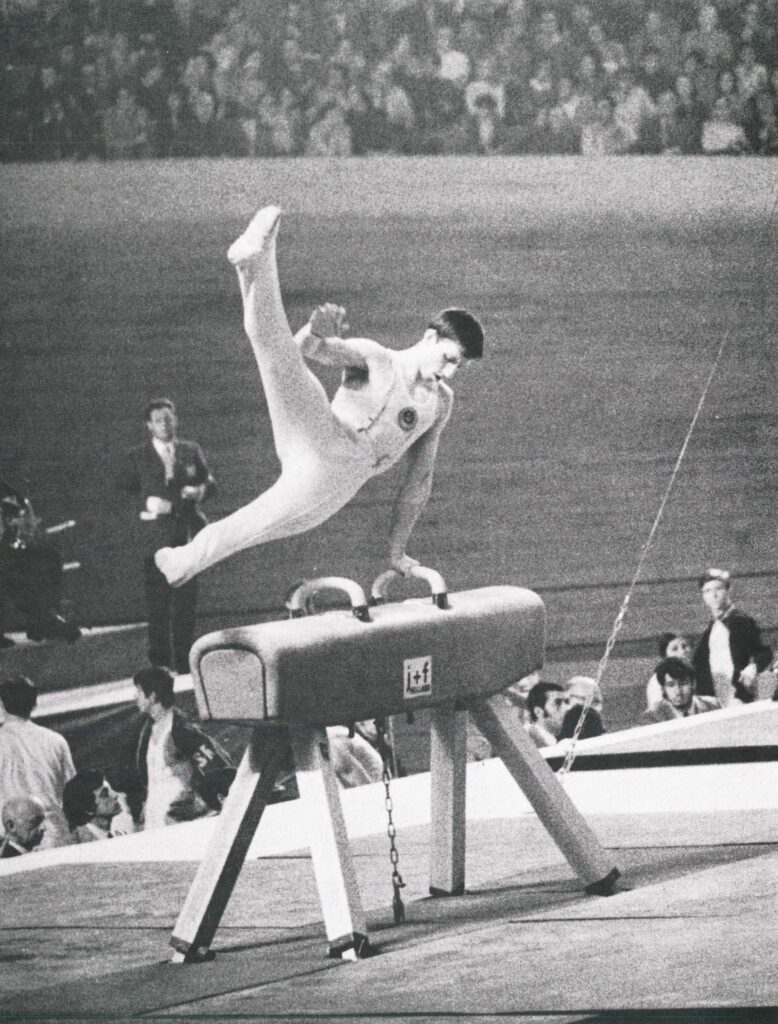
Quick Links: The All-Around | The Event Finals with Videos | Additional Video
Reminder: After the 1971 European Championships, there was a big to-do about the hairstyles of male gymnasts. You can read about it here.
The All-Around Competition
Voronin was the clear favorite coming into the competition.
This event, which only includes an individual tournament in which each nation can enter a maximum of three gymnasts, should not in fact escape Voronin, who won it in 1967 in Tampere and in 1969 in Warsaw. Barred on the world level by the Japanese who for several years have been collecting world and Olympic titles, the 26-year-old Soviet seems to have this year again a sufficient margin of safety to prevail and adorn himself with the title of champion of Europe, as the European Cup gives him the right to do.
L’Express, May 13, 1971
Cette épreuve, qui ne comporte qu’un tournoi individuel dans lequel chaque nation peut engager un maximum do trois gymnastes, ne devrait en effet pas échapper à Voronine, qui la remporta en 1967 à Tampere et en 1969 à Varsovie. Barré sur le plan mondial par les Japonais qui depuis plusieurs années collectionnent les titres mondiaux et olympiques, le Soviétique, âgé de 26 ans, semble posséder cette année encore une marge de sécurité suffisante pour s’imposer et se parer du titre de champion d’Europe, comme lui en donne le droit la coupe d’Europe.
The question was whether Klimenko could beat him.
The question is whether Klimenko who finished 7th in Mexico almost two points behind Voronin (113.95 against 115.85) has progressed enough. Voronin currently seems in good shape. He finished second at the Winnipeg tournament, won by a Japanese, but Klimenko also showed his talent at the start of the season. He took third place in a tournament in Japan in Nagoya, behind the Japanese Nakayama and Kasamatsu. In Ljubljana, during the last world championships, Voronin ranks 4th with 113.575, just ahead of Klimenko (113.6).
L’Express, May 13, 1971
La question est de savoir si Klimenko qui termina 7me à Mexico avec près de deux points de retard sur Voronine (113,95 contre 115,85) a suffisamment progressé. Voronine semble actuellement en bonne forme. Il a terminé second au tournoi de Winnipeg, remporté par un Japonais, mais Klimenko a également fait preuve en début de saison de ses bonnes dispositions. Il a pris la troisième place d’un tournoi au Japon à Nagoya, derrière les Japonais Nakayama et Kasamatsu. A Ljubljana, lors des derniers championnats du monde, Voronine se classe 4me avec 113,575, juste devant Klimenko (113,6).
Voronin vs. Klimenko was seen as a battle of styles.
Will Voronin be able to maintain his supremacy or will he have to give way to his more original and risky gymnastics compatriot for the first time?
Der Bund, May 14, 1971
Wird Woronin seine Vormachtstellung behaupten können oder muss er erstmals seinem origineller und riskanter turnenden Landsmann den Vortritt lassen?
The competition came down to the last routine.
Klimenko and Voronin fought a duel for the title, which was only decided in the last exercise. After four exercises, both gymnasts were at the same level, after five, Klimenko led by 0.15 points, and after 9.60 points from the new European champion in the final routine, Voronin would have had to achieve 9.75 to become European champion for the third time in a row. But he “only” got a score of 9.60.
Neues Deutschland, May 16, 1971
Klimenko und Woronin lieferten sich einen Zweikampf um den Titel, der erst mit der letzten Übung entschieden wurde. Nach vier Geräten lagen beide Turner auf gleicher Höhe, nach fünf Disziplinen führte Klimenko mit 0,15 Punkten und und nach den 9,60 Punkten des neuen Europameisters am abschließenden Rede hätte Woronin eine 9,75 turnen müssen, um zum dritten Male hintereinander Europameister zu werden. Doch es langte „nur” zu Note 9,60.
In the end, Klimenko won. He represented youthfulness and originality, which the Code of Points valued, whereas Voronin represented classicism.
A 21-year-old student, Viktor Klimenko, ended the reign of one of Europe’s most prestigious gymnasts, Mikhail Voronin, by winning the ninth European Cup in Madrid and thus preventing Voronin from adorning himself with a third consecutive title of European champion. This defeat of Voronin undoubtedly marks a turning point in the history of gymnastics because more than an opposition of men it is an opposition of style that the 5,000 spectators present at the Palacio de Esportes were able to view. On the one hand, it was Voronin’s classicism, always exceptional on rings but which has not been able to reinvent itself, especially on floor. On the other, it was the youth, the ardor of Klimenko, a well-proportioned athlete, passionate about soccer, and who sought originality in all his exercises.
L’Impartial, May 15, 1971
Un jeune étudiant de 21 ans, Victor Klimenko, a mis fin au règne d’un des plus prestigieux gymnastes que l’Europe ait jamais connu, Michel Voronine, en remportant à Madrid la neuvième Coupe d’Europe et en empêchant ainsi Voronine de se parer d’un troisième titre consécutif de champion d’Europe. Cette défaite de Voronine marque sans doute un tournant dans l’ histoire de la gymnastique car plus qu’une opposition d’hommes c’est à une opposition de style que les 5000 spectateurs présents au Palais des Sports ont pu assister. D’un côté, c’était le classicisme de Voronine toujours exceptionnel aux anneaux mais qui n’a pas su se renouveler, notamment au sol. De l’autre, c’était la jeunesse, l’ardeur de Klimenko, un athlète bien proportionné, passionné de football, et qui a cherché l’originalité dans tous ses exercices.
By taking the top three spots in the all-around, the Soviets confirmed their superiority in Europe.
After the double victory four years ago in Tampere and two years ago in Warsaw, the Soviet athletes received all three medals this time and thus impressively confirmed their leading positions in Europe.
Neues Deutschland, May 16, 1971
Nach dem Doppelsieg vor vier Jahren in Tampere und vor zwei Jahren in Warschau nahmen die sowjetischen Aktiven diesmal alle drei Medaillen in Empfang und bestätigten damit in eindrucksvoller Weise Ihre führende Stellung in Europa.
Results
| Gymnast | Country | FX | PH | SR | VT | PB | HB | Total |
| 1. Klimenko, Viktor | URS | 9.40 | 9.55 | 9.35 | 9.40 | 9.60 | 9.60 | 56.90 |
| 2. Voronin, Mikhail | URS | 9.25 | 9.55 | 9.60 | 9.30 | 9.45 | 9.55 | 56.70 |
| 3. Andrianov, Nikolai | URS | 9.30 | 9.45 | 9.35 | 9.35 | 9.35 | 9.45 | 56.25 |
| 4. Köste, Klaus | GDR | 9.25 | 9.20 | 9.10 | 9.25 | 9.45 | 9.50 | 55.75 |
| 5. Szajna, Andrzej | POL | 9.20 | 8.95 | 9.30 | 9.45 | 9.30 | 9.50 | 55.70 |
| 6. Mößinger, Walter | FRG | 9.35 | 9.20 | 9.15 | 9.15 | 9.25 | 9.25 | 55.35 |
| 7. Kubica, Sylwester | POL | 9.25 | 9.20 | 9.30 | 9.10 | 9.20 | 9.25 | 55.35 |
| 8. Rohner, Peter | SUI | 9.20 | 9.25 | 9.30 | 9.15 | 9.10 | 9.20 | 55.20 |
| 9. Hürzeler, Roland | SUI | 8.90 | 9.40 | 9.10 | 8.90 | 9.35 | 9.45 | 55.10 |
| 10. Netušil, Miloslav | TCH | 9.05 | 9.00 | 9.20 | 8.90 | 9.45 | 9.40 | 55.00 |
| 11. Brehme, Mathias | GDR | 9.05 | 9.40 | 9.35 | 9.15 | 8.90 | 9.10 | 54.95 |
| 12. Brodnik, Janez | YUG | 9.10 | 9.15 | 8.90 | 9.05 | 9.20 | 9.45 | 54.85 |
| 13. Gienger, Eberhard | FRG | 9.05 | 9.35 | 8.95 | 9.20 | 8.85 | 9.40 | 54.80 |
| 14. Fejtek, Jiří | TCH | 8.70 | 9.30 | 9.30 | 9.05 | 9.20 | 9.20 | 54.75 |
| 15. Carminucci, Giovanni | ITA | 9.00 | 9.20 | 8.90 | 9.10 | 9.40 | 9.10 | 54.70 |
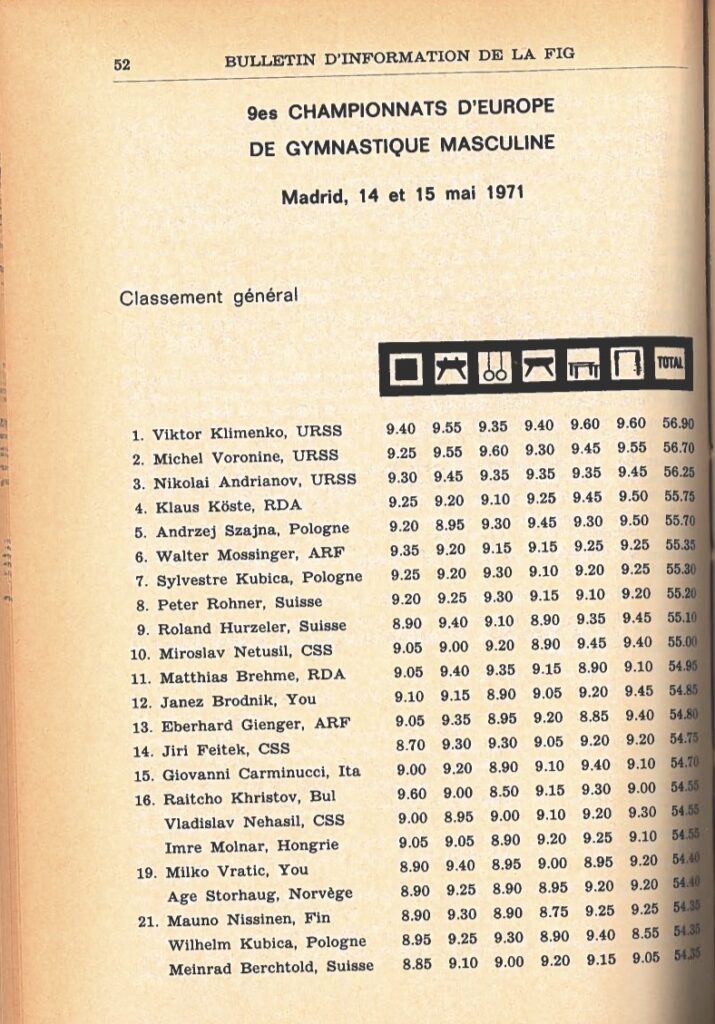
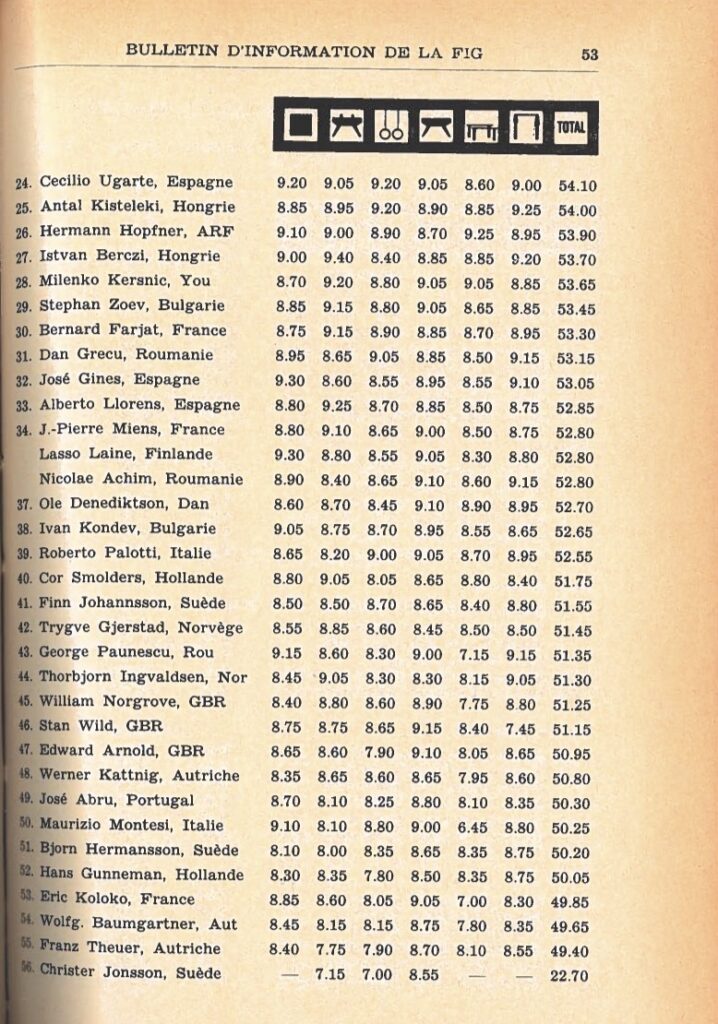
The amount of difficulty was increasing. More twisting was required.
Our [Swiss] trio had to start the all-around on vault, where Berchtold particularly stood out. But half turns around the longitudinal axis and simple somersaults are no longer enough to get to the top. The situation was similar on parallel bars, where Rohner and Berchtold completed a forward somersault with “only” half a twist.
Der Bund, May 17, 1971
Unser Kleeblatt hatte den Sechskampf mit dem Pferdsprung zu beginnen wo besonders Berchtold hervorstach. Aber halbe Drehungen um die Längsachse und einfache Salti genügen bereits nicht mehr um obenaus zu kommen. Aehnlich verhielt es sich am Barren wo Rohner und Berchtold mit Salto vorwärts mit «nur» halber Drehung abschlössen.
Fun fact: A Kleeblatt is a cloverleaf in German, but in this sentence, it means a trio.
Note: Twisting may have been becoming more common, but Carminucci won gold on parallel bars with a simple layout dismount.
The judging was highly partisan with East German and West German judges giving vastly different scores on parallel bars.
After Brehme of East Germany botched his Stütz on parallel bars, the German judges gave vastly different scores:
The score of 8.90, however, only came out after a long discussion by the judges, because Brehme’s compatriot, who was on the parallel bars jury, gave 9.30, while the West German judge only gave 8.20.
Der Bund, May 17, 1971
[D]er Ostdeutsche Brehme verlor das Rennen frühzeitig indem er am Barren nach dem Schwabenhupf zum Stütz einknickte und bei der anschliessenden Stützkehre die Beine verwarf. Die Note 8,90 kam allerdings erst nach langer Diskussion des Kampfgerichts heraus weil Brehmes in der Barrenjury sitzender Landsmann 9,30 der westdeutsche Kampfrichter dagegen nur 8,20 gab.
The West Germans were happy with their progress at the European Championships.
[…] the excellent performance at the European Championships, where our gymnasts noticeably shortened the gap to the Russians, who are still unrivaled in Europe, and closed the gap to all other European gymnastics nations . Even to Klaus Koeste and Mathias Brehme (GDR), the gap between our two top gymnasts Walter Mößinger and Eberhard Gienger is hardly noticeable.
Jahrbuch der Turnkunst, 1972
[…] und zu allen anderen europäischen Turnernationen aufschlossen. Selbst zu einem Klaus Koeste und Mathias Brehme (DDR) ist der Abstand bei unseren zwei Spitzenturnern Walter Mößinger und Eberhard Gienger kaum noch spürbar.
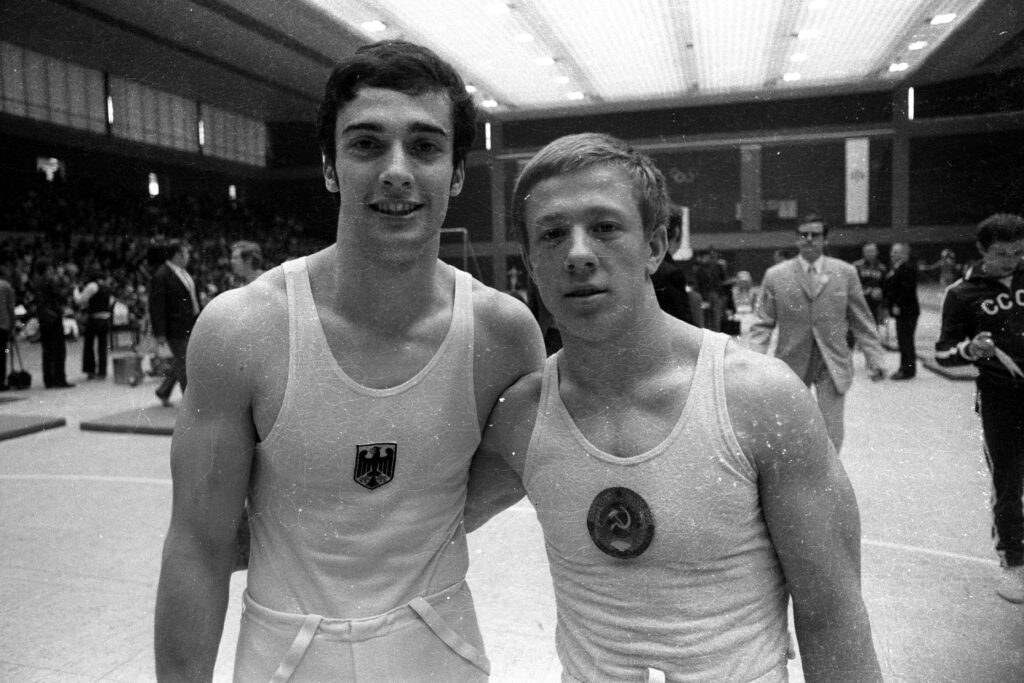
Event Finals
The Big News: Klimenko tore his Achilles during the warm-ups on floor.
While preparing for the final exercises, the new all-around European champion Klimenko tore the Achilles tendon of his left foot. He had to be carried away and withdraw from the event finals.
Der Bund, May 17, 1971
Beim Eintumen zu den Finalfreiübungen riss der neue Sechskampf-Europa-meister Klimenko die Achillessehne des linken Fusses an. Er musste weggetragen werden und auf die Teilnahme an den Finalkämpfen verzichten.
To win, gymnasts had to stand out by showing some kind of novel element.
In Madrid, it seemed that the exercises became a bit monotonous. That is why there was not one case — especially in the apparatus finals — when in the many exercises of the same standard and almost equally beautifully executed, a single small “innovation,” a not always difficult or risky but surprising, new movement, connection, or a novel composition brought its user to the podium and to victory.
Népsport, May 21, 1971
Madridban úgy tűnt, kicsit egyhangúakká váltak a gyakorlatok. Éppen ezért nem egy olyan eset volt — elsősorban a szerenkénti döntőben —, amikor a sok egyforma színvonalú és szinte egyformán jól, szépen kivitelezett gyakorlatban egyetlen kis „újítás”, egy nem is mindig nehéz, vagy kockázatos, de meglepő, új mozdulat, kötés, vagy újszerű összetétel dobogóra, győzelemhez juttatta az alkalmazóját.
Floor Exercise
| Gymnast | Country | Quals. | Finals | Total |
| 1. Hristov | BUL | 9.60 | 9.50 | 19.10 |
| 2. Ginés, José | ESP | 9.30 | 9.45 | 18.75 |
| 3. Andrianov | URS | 9.30 | 9.40 | 18.70 |
| 4T. Mößinger | FRG | 9.35 | 9.20 | 18.55 |
| 4T. Laine, Lasse | FIN | 9.30 | 9.25 | 18.55 |
| 6. Köste | GDR | 9.25 | 9.25 | 18.50 |
Double backs were becoming more common. Would floor with music come next?
Four of the six finalists on the floor showed a double back somersault. The straight arm giant swing on the rings became a classic movement, even for most of the gymnasts in the middle group. The majority of the dismounts contained twist movements. We are curious to know whether the time is near when musical accompaniment will be accepted in the floor exercise. We observed already in Prague, 1965, a Russian gymnast who tried this successfully, not in a competition, but during a demonstration.
Modern Gymnast, Nov. 1971
Hristov defended his European title, and Ginés may have been boosted to silver thanks to the home crowd.
Christov’s victory on the floor exercise confirmed that for the moment only Endo’s boys [i.e. the Japanese] can do better in this discipline. Although we can’t really say that Gines (Spain) wasn’t worth a place in the finals, his silver medal was partially from the benefit of an enthusiastic home ground.
Modern Gymnast, Nov. 1971
While there were rules for the intervention of the head judges, the head judges often did what they wanted to do.
Here’s what the Hungarian press reported:
Head coach István Sárkány, who judged floor during the all-around competition, said that the head judge raised Bulgarian Hristov’s score by two tenths with the justification that the Bulgarian competitor also presented an original movement and this should be rewarded.
Népsport, May 21, 1971
Sárkány István vezető edző, aki az összetett versenyben a műszabadgyakorlatnál pontozott, mesélte, hogy a vezető bíró a bolgár Hrisztov gyakorlatára adott pontszámát két tizeddel felemeltette azzal az indoklással, hogy a bolgár versenyző egy eredeti mozdulatot is bemutatott és ezt jutalmazni kell.
You can watch Ginés’s routine here:
Note: It was common to roll out of a double back at the time. (In the United States, it was called a “circus double back.”) But it wasn’t necessarily common to dismount with a double full.
Pommel Horse
| Gymnast | Country | Quals | Finals | Total |
| 1. Andrianov | URS | 9.45 | 9.45 | 18.90 |
| 2. Brehme | GDR | 9.40 | 9.35 | 18.75 |
| 3. Voronin | URS | 9.55 | 9.15 | 18.70 |
| 4. Bérzci, István | HUN | 9.40 | 9.20 | 18.60 |
| 5. Hürzeler | SUI | 9.40 | 9.10 | 18.50 |
| 6. Vratič, Miloš | YUG | 9.40 | 8.70 | 18.10 |
According to Hungary’s head coach, István Sárkány, pommel horse was boring.
The exercises on pommel horse were characterized by a large amount of material, but monotony.
Three gymnasts who significantly deviated from the template can be mentioned: Voronin, Brehme, and István Bérczi.
Nepsport, May 21, 1971
A lólengésnél látott gyakorlatokat a nagy anyag, de egyhangúság jellemezte.
Három tornászt lehet említeni, aki jelentősen eltért a sablontól: Voronyin, Brehme és Bérczi István.
You can watch Andrianov’s routine here:
Rings
| Gymnast | Country | Quals | Finals | Total |
| 1. Voronin | URS | 9.60 | 9.65 | 19.25 |
| 2. Andrianov | URS | 9.35 | 9.45 | 18.80 |
| 3. Szajna | POL | 9.30 | 9.40 | 18.70 |
| 4. Brehme | GDR | 9.35 | 9.30 | 18.65 |
| 5. Kubica, S. | POL | 9.30 | 9.20 | 18.50 |
| 6. Rohner | SUI | 9.30 | 8.50 | 17.80 |
According to the Hungarians…
On rings, Voronin stood out from the field. His new movement (shoulder roll into inverted cross) is a difficult and beautiful element!
Nepsport, May 21, 1971
Gyűrűn Voronyin emelkedett ki a mezőnyből. Új mozdulata (vállkifordulás fordított keresztfüggésbe) nehéz és szép elem!
Voronin on rings:
Vault
| Gymnast | Country | Quals | Finals | Total |
| 1. Andrianov | URS | 9.350 | 9.400 | 18.750 |
| 2. Szajna | POL | 9.450 | 9.225 | 18.675 |
| 3. Köste | GDR | 9.250 | 9.250 | 18.500 |
| 4. Molnár, Imre | HUN | 9.200 | 9.200 | 18.400 |
| 5. Voronin | URS | 9.300 | 9.075 | 18.375 |
| 6. Gienger | FRG | 9.200 | 8.875 | 18.075 |
The new Code of Points made vault less boring.
The new rules in the FIG code have pushed more gymnasts to take greater risks in the vaulting event, which as a result of this, unquestionably gained a lot of attraction. The Tsukahara Vault has already received full attention in several countries.
Modern Gymnast, Nov. 1971
Reminder: In 1969, there was talk of abandoning vault altogether in part because the event was so boring.
Voronin’s and Andrianov’s vaults can be seen here. Andrianov had extremely clean form on his handspring front tuck.
Parallel Bars
| Gymnast | Country | Quals. | Finals | Total |
| 1. Carminucci | ITA | 9.40 | 9.45 | 18.85 |
| 2T. Andrianov | URS | 9.35 | 9.45 | 18.80 |
| 2T. Köste | GDR | 9.45 | 9.35 | 18.80 |
| 2T. Voronin | URS | 9.45 | 9.35 | 18.80 |
| 5T. Kubica, W. | POL | 9.40 | 9.35 | 18.75 |
| 5T. Netušil | TCH | 9.45 | 9.30 | 18.75 |
Carminucci’s routine can be found here:
Note: The Carminucci is still in the Code of Points. It’s a B.

High Bar
| Gymnast | Country | Quals. | Finals | Total |
| 1. Köste | GDR | 9.50 | 9.55 | 19.05 |
| 2. Voronin | URS | 9.45 | 9.50 | 18.95 |
| 3. Hürzeler | SUI | 9.35 | 9.50 | 18.85 |
| 4. Szajna | POL | 9.30 | 9.50 | 18.80 |
| 5T. Brodnik | YUG | 9.20 | 9.45 | 18.65 |
| 5T. Netušil | TCH | 9.40 | 9.25 | 18.65 |
Köste won East Germany’s first European gold in men’s gymnastics.
At the end of the 9th European Championships in Gymnastics, the national anthem of the GDR played late on Saturday evening in the Palacio de Deportes in Madrid, and the GDR’s national flag rose on the highest victory pole. Klause Köste became a gold medalist on the horizontal bar and thus brought a European Championship title to the GDR for the first time. The 28-year-old from Leipzig made an excellent impression, safely performing the toe-on front dismount, and scored the highest final score on this exercise with 9.55 points.
Neues Deutschland, May 17, 1971
Zum Abschluß der IX. Europameisterschaften im Turnen erklang am späten Sonnabendabend im Palaclo de Deportes zu Madrid die Nationalhymne der DDR, stieg die Nationalflagge der DDR am höchsten Siegesmast empor. Klaus Koste wurde Goldmedaillengewinner am Reck und holte damit zum ersten mal einen Europameistertitel im Männerturnen in die DDR. Der 28jäihrige Leipziger hinterließ einen ausgezeichneten Eindruck, stand den Unterschwungsalto als Abgang sicher und erzielte mit 0,55 Punkten die höchste Finalnote an diesem Gerät.
Hürzeler won Switzerland’s first medal at Euros in 10 years.
When Hürzeler went on the horizontal bar, it was in the very last minutes of this memorable championship. After the straddle circle to the half stalder while changing grip to the double endo swing, he was like a candle in the handstand, and we held our breath. But with all his energy, he forced his body into the right sequence and completed the exercise, which he performed in perfect posture, with a powerful straddle hecht.
Der Bund, May 17, 1971
Als Hürzeler dann am Reck – es war in den allerletzten Minuten dieser denkwürdigen Meisterschaft – nach dem Kreisgrätschen zur halben Staldergrätsche beim Griffwechsel zum doppelten Endogrätschumschwung wie eine Kerze im Handstand stehen blieb hielten wir den Atem an. Aber mit aller Energie zwang er den Körper in den richtigen Ablauf und schloss die in einwandfreier Haltung durchgcturnte Uebung mit wuchtiger Hechtgrätsche ab.
Note: Swiss gymnast Ernst Fivian tied for bronze on vault in 1961.
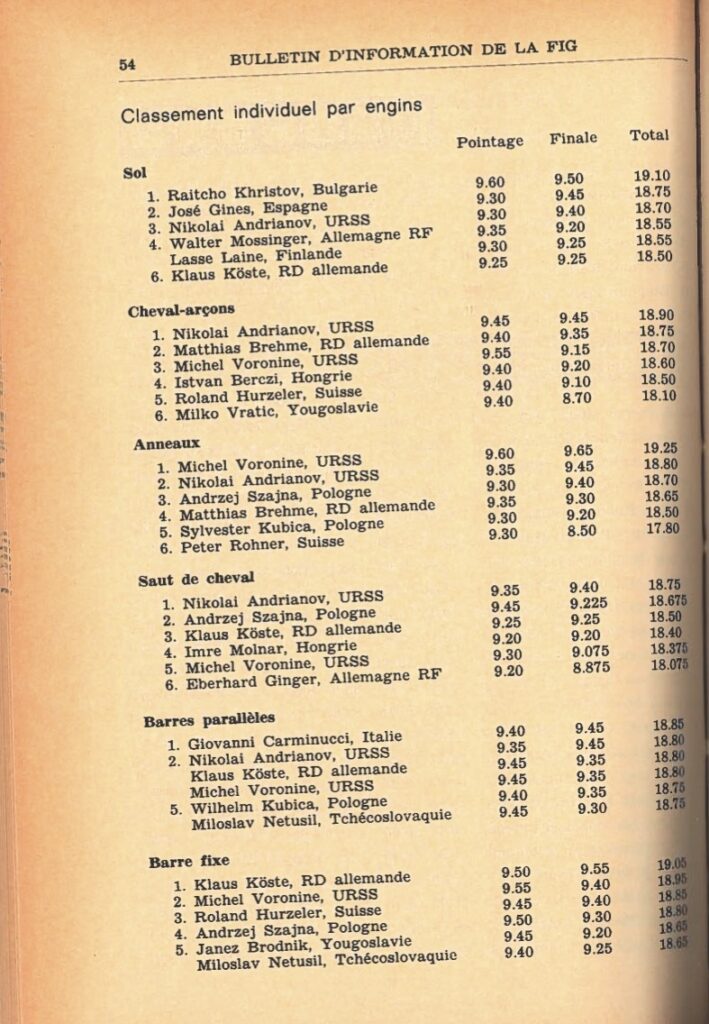
Video
You can watch more (partial) routines from the competition in this video.
Note: The video opens with video footage of Joaquim (Joaquín, en castellano) Blume, who was the 1957 European All-Around Champion. He died in a plane crash in 1959.
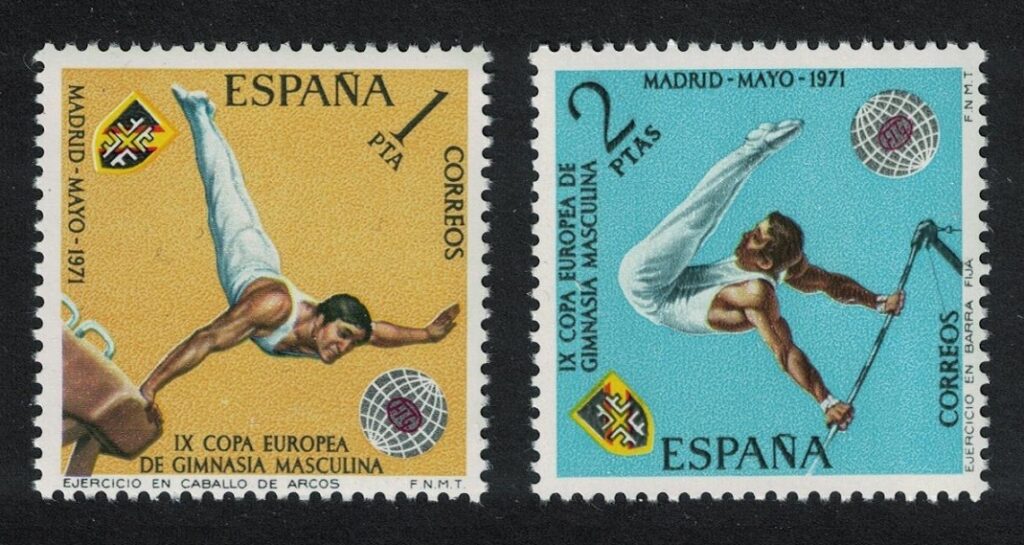
More on 1971